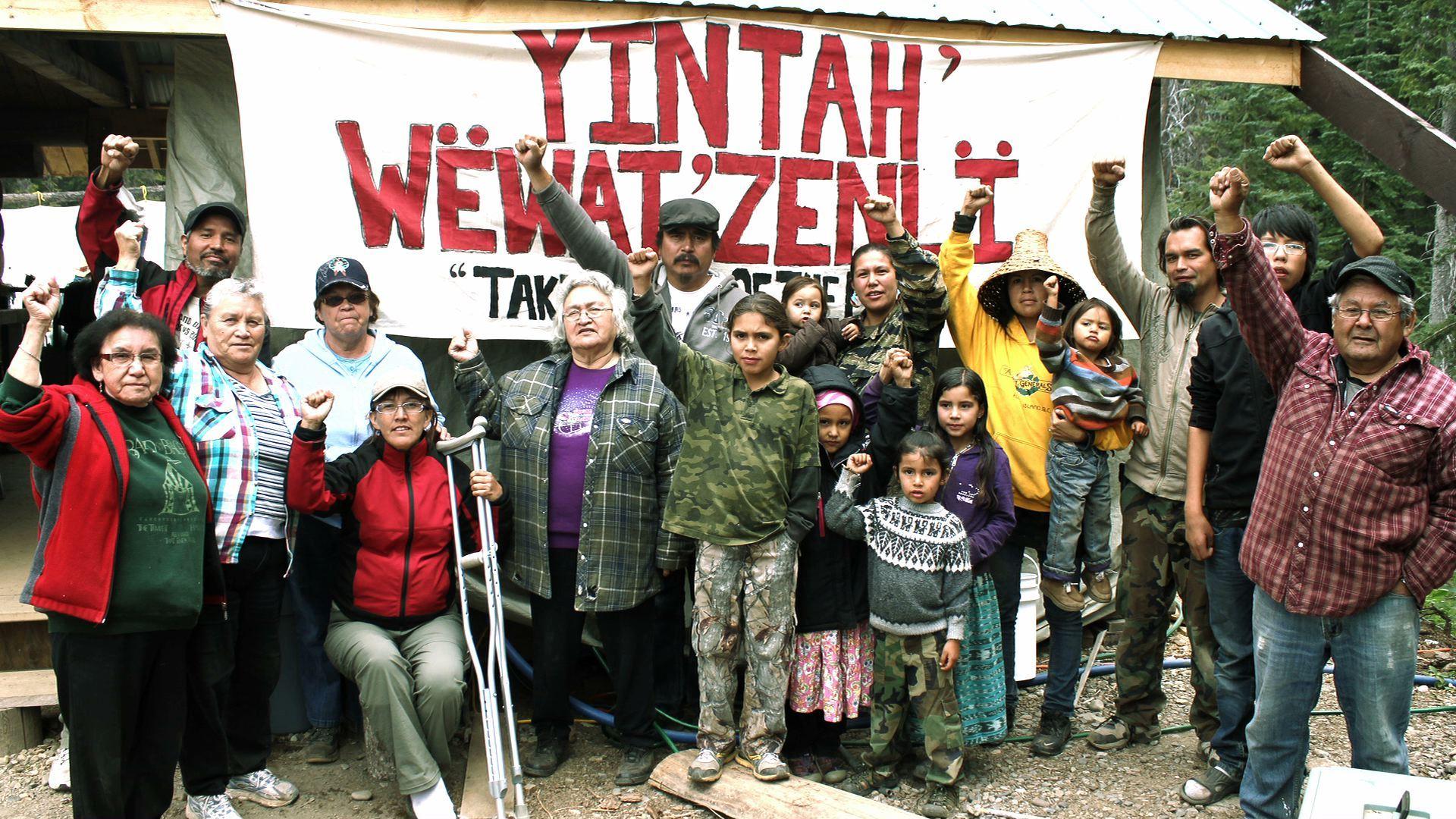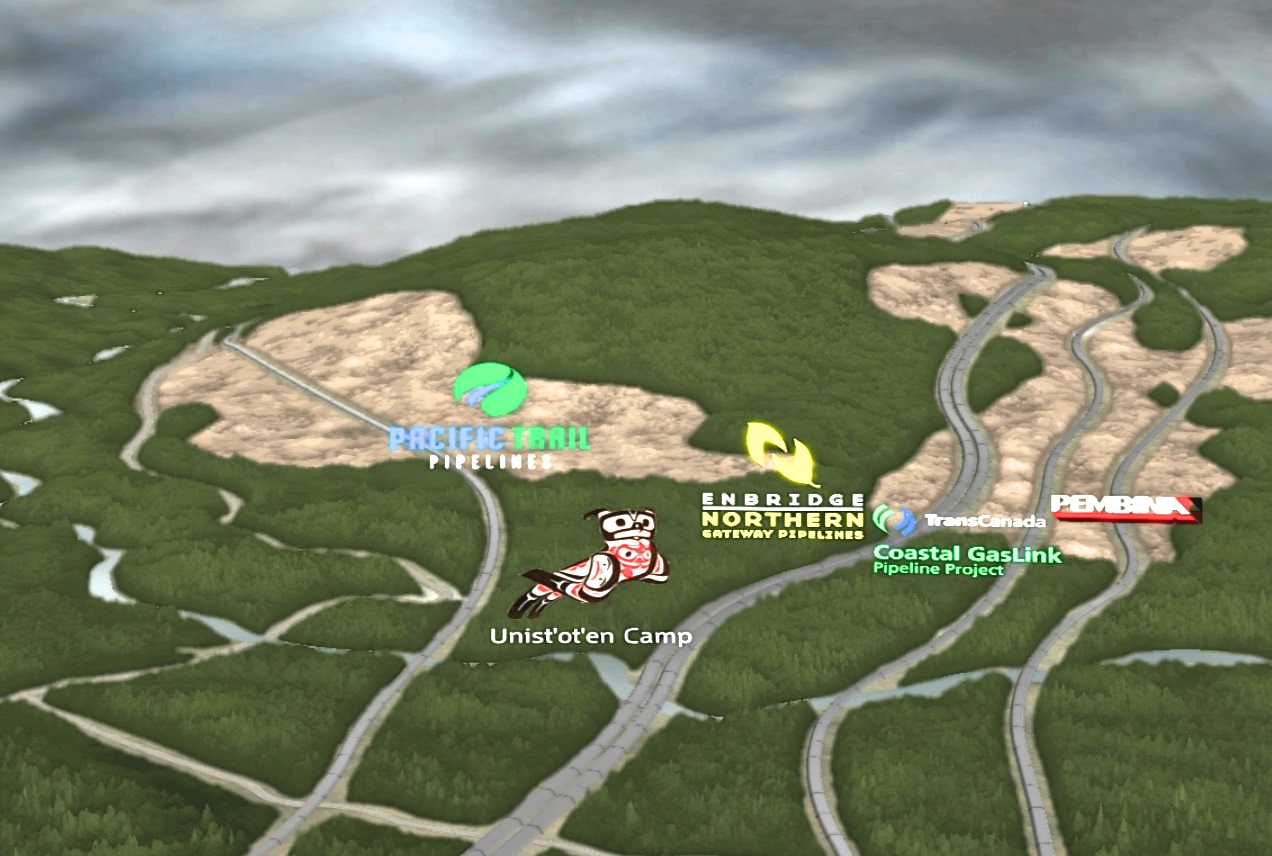Rosa Parks famously occupied the seat of a Montgomery bus, an action that sparked a revolution in U.S. racial relations. The Unist’ot’en clan of the Wet’suwet’en now defiantly occupies territory whose location is critical to a proposed new pipeline route. They experience daily surveillance by helicopters that sometimes buzz close over the main cabin of the occupation.
Although the primary purpose of the Unist’ot’en stand is to block pipeline construction, their effort highlights Canada’s long history of attempts to silence, remove and run roughshod over Indigenous peoples who lived across northern North America for thousands of years before settlers showed up. Recent resistance by Mi’kmaq at Elsipogtog in New Brunswick dramatizes the injustice that stretches right across the four thousand miles of the modern state called Canada.
Corporate interests are attempting to drive a set of pipelines through northern British Columbia wilderness, across lands that have never been ceded through treaty. The primary perpetrators in this instance are the Kitimat LNG project (a partnership between Apache Canada Ltd. and Chevron Canada Limited) and Enbridge Northern Gateway Pipelines (a creation of Enbridge Inc.).
Canada’s own legal system says these lands do not really belong to Canada. Yet industry and settler governments show repeated readiness to use subterfuge and illegitimate force to try take over lands that still belong to Indigenous peoples.
Unist’ot’en resistance promises to mark a turning point in the history of the colonial constructs named British Columbia and Canada. Over a century of abusive resource extraction already scars a thinly populated BC hinterland. The impact of multiple pipelines laid along a proposed new path would make already existing environmental damage look like tiny scratches. The devastations that the pipelines tie into – accelerated tar sands expansion, hydraulic fracking that injects massive chemical cocktails into the earth – would go far beyond the considerable impacts of the pipelines themselves.
The additional industrial activity would also pose unacceptable risks of rendering the land itself uninhabitable, whether through accidental toxic spillage, through routine noxious extraction and processing of carbons, or through flooding of farmland to generate huge new hydroelectric capacity for compression and transport of fracked gas.
BC and Pipelines
Canada’s west-coast province of British Columbia stretches 800 miles northward from Washington State up to Alaska. BC is over one-third larger than Texas, but only a little over half the size of Alaska. A distribution map of current BC population shows that over half of the current 4.4 million residents concentrate in the southwest corner, with much of the remainder spread out along the southern border. Driving a vehicle from Vancouver to the Unist’ot’en camp takes about sixteen hours.
The Pacific Trails Pipeline seeks to blaze a “trail” right across the middle of BC, from Summit Lake near Prince George to the Pacific coast at Kitimat. In the wake of PTP would follow the better-known and even more contentious Enbridge Northern Gateway pipeline, designed to transport raw diluted bitumen from the Alberta tar sands to tanker ships.
Even more pipelines are lining up behind these two to expand that proposed new corridor. Beyond the port at the coast, tankers would face navigation of ocean channels notorious for treacherous currents, extreme and changeable weather, and absence of safer open water.

This Is Unist’ot’en Territory
Unist’ot’en traditional territory sits roughly in the center of BC. Since July 2010, the Unist’ot’en have defended their lands through residence at a permanent camp that has been expanding around a substantial all-seasons cabin. All who wish to enter the area are expected to do so only on the basis of submitting to the free, prior, and informed consent protocol of the Unist’ot’en. On at least three occasions the Unist’ot’en have issued formal notice of expulsion to pipeline trespassers.
Unist’ot’en land has never been ceded to any colonial authority. Compromised and presumptive Indian Act tribal councils and bands have no legitimate jurisdiction. Rule is exercised by hereditary chiefs and matriarchs.
Most who approach Unist’ot’en territory travel 66 kilometers of gravel road from the town of Houston (midway between Burns Lake and Smithers on Yellowhead Hwy 16). At the Morice River bridge, a sign warns all travelers that consent is required before the river boundary can be crossed.
The Unist’ot’en location is highly strategic. The territory lies directly in a path mapped out for a set of proposed pipelines that resource exploiters hope to ram through extremely difficult wilderness terrain. The immediate local topography poses a bottleneck for would-be pipeline trailblazers. A confluence of rivers and streams lies immediately to the north, and elevations ranging to above 1800 meters lie immediately to the south.

Supporting the Defense of the Land
In mid-July 2013, about 200 people gathered on Unist’ot’en land for the 4th Annual Action Camp. This event is designed to further education, networking, strategizing, and development of off-site bases of support. Before and after this large-scale event, several work camps assisted in continuing to build infrastructure and prepare supplies.
Construction began in late spring on a new dwelling, a traditional pithouse. Situated on higher land further back from the river, this new project occupies a second position that a slightly rerouted pipeline might attempt to pass through. When completed, the structure is intended to become the full-time winter home for the main family of defenders.
In October, a work crew selected and felled trees, fire-treated logs and installed about half of the walling, preparatory to heaping earth against the logs. Mid-November freeze-up prevents further pithouse development until spring.
One of the helpers on the pithouse was an experienced construction worker who self-describes as a city person. Their first-time October experience of the remote setting left them with increased desire to explore the history of their own still-traceable indigenous connection to land in northern Europe.
One other 2013 project was development of a permaculture garden that takes advantage of orientation to sun and rehabilitates an area suffering from previous unsustainable logging. The October work crew helped with preparation for storage of late-harvest foods like carrots and kale. As well, they assisted with putting up deer and moose meat for the winter. Preservation tasks involved cutting strips of flesh to smoke-treat for jerky, and pressure canning of chunks in large glass jars.
A second helper who worked mainly with food preservation comes from a very small town that could be considered remote on account of its thirty-mile distance from a regional center. Their first-time October stay at the camp left them in awe of how remote the Unist’ot’en setting is by comparison. In less than a week they sensed a clear shift into a different daily cycle oriented to work with unquestionable meaning.
A third helper, a participant in the 2011 action camp, remained into later October and anticipates going back early next year for a longer-term stay. Their contribution included work on various stages in the preparation of animal hides: scraping, treating, and stretching. That extended connection with the slaughtered animals brought experience of a spiritual dimension that carried into meal times and prayer for the food being eaten.
All three of these helpers asked that this account of their support for the Unist’ot’en camp minimize common journalistic personalizations.
Recent Attacks and Resulting Equipment Needs
On October 28, 2013, an unprecedented direct attack put land defenders on increased alert. Chief Toghestiy described the event in an in-person interview on November 15. People who were gathered in the cabin for the evening heard an explosion shortly after 10:00 p.m. Once they distinguished the sound from what was being heard on a TV show, cautious reconnaissance commenced.
Chief Toghestiy dismissed assessment of the occurrence as “scary” and proceeded to describe a rapid, calm, methodic and effective response. On the far side of the bridge the responders eventually discovered that a trail of fuel had led to a cluster of four-liter plastic containers, apparently filled with a petroleum-based substance capable of forceful ignition. The placement of the device suggests a desire to intimidate by inflicting damage to the Unist'ot'en sign.
The outcome may also reflect attacker incompetence. A few days later a different bridge in the immediate area suffered an arson attack. The aftermath of the first attack can be viewed in a photograph that accompanies an account of the second incident.
A campaign is presently underway to raise funds for Unist’ot’en Camp defense. The additional resources are needed to improve Unist’ot’en ability to patrol territory. The basic mission is to deter or intercept attackers, and to confront as quickly as possibly any helicopter landings made by pipeline agents (surveyors, loggers, etc.).
Specifics include security cameras, motion sensors, night-vision equipment, and an all-terrain snowmobile. As recounted on the Camp’sFacebook page, two of their existing snowmobiles were appropriated and then smashed by drunken thieves. In the aftermath both RCMP police and ICBC insurance denied all recourse or compensation.
Resistance Brings Response
Less than two weeks ago, on November 14, Canada’s largest private sector union, representing over 300,000 workers, called for “a Canada-wide moratorium on all new oil and gas fracking” due to “the safety and environmental risks associated with fracking as well as the lack of informed consent by First Nations about fracking activities on traditional lands." Their statement supports Indigenous nonviolent resistance to this form of resource exploitation on their lands.
And on the afternoon of November 16, Freda Huson and Toghestiy from the Unist'oten Camp spoke to hundreds at a Defend Our Climate Rally held in Vancouver. A video of that event can be viewed here.
3 WAYS TO SHOW YOUR SUPPORT
- Log in to post comments



















